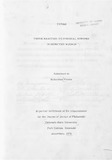Tissue reaction to surgical sutures in infected wounds
Abstract
A comparison was made between Dexon (braided polyglycolic
acid), plain catgut, chromic catgut, multifilament steel, monbfilament
nylon, braided silk and Mersilene (braided dacron) in infected
wounds.
Four groups of 15 dogs were used. Three identical rows of 27
subcutaneous pockets were created in each dog. Knots of 3/0 suture
were embedded in the pockets. Each suture pocket in the first row
was inoculated with O. 1 milliliter of a standard culture of Staphy-
1 .. 416 ococcus aureus, containing 7 x 0 organisms. The other two rows
received similar treatment with ten-fold and hundred -fo Id dilutions
respectively. Each row had a control pocket inoculated with culture
but no suture material, and a second pocket with only the culture
medium.
Groups of dogs were sacrificed at 6, 10, 20 and 40 days
respectively. The diameter of the lesion around each suture was
measured grossly. Microscopic measurements of lesions and celluIa r infiltration were used to rate the tissue reactions subjectively.
Pockets containing suture materials had significantly more
reaction than control pockets. The three dilutions of culture
iii
produced significantly different reactions. In the acute stage of
infection (6 days), steel and nylon elicited the least reaction and
catgut produced the most. Silk, Mersilene and Dexon were intermediate.
In more chronic stages (10, 20 and 40 days), relative
reactions to Mersilene and silk increased. Although Dexon showed
intense tissue reaction at 6 days, it elicited relatively little in
chronic implantations. Steel and nylon remained relatively inert at
all stages. At 20 and 40 days silk evoked the most intense reaction.
Microscopic measurements of lesions correlated well with
gros s measurements. Neutrophils were the predominant cells in the
acute stage. Later, macrophages and fibroblasts predominated.
Silk, Mersilene and the catguts .attracted large numbers of neutrophils
in chronic implantations, suggesting pe rsistence of infection. The
Splendor-Hoeppli phenomenon was demonstrated around silk sutures
at 40 days.
Suture materials play an important role in postoperative wound
infections, and different suture materials elicit different degrees of
reaction in contaminated wounds. In chronic implantations, the
reaction to various suture materials differs from that observed in the
acute stages of infection.
Citation
In partial fufilmint nt of the requirern.ent s for the Degree of Doctor of Philosophy Colorado State University fort Collins, Colorado December r , 1976Publisher
Clinical Sciences, Colorado State University

